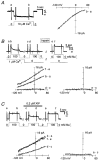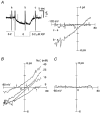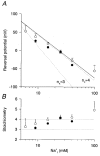Stoichiometry of Na+-Ca2+ exchange in inside-out patches excised from guinea-pig ventricular myocytes
- PMID: 10699079
- PMCID: PMC2269815
- DOI: 10.1111/j.1469-7793.2000.t01-2-00339.x
Stoichiometry of Na+-Ca2+ exchange in inside-out patches excised from guinea-pig ventricular myocytes
Abstract
1. The stoichiometry (nx) of cardiac Na+-Ca2+ exchange was examined by measuring the reversal potential of the Na+-Ca2+ exchange current (INa-Ca) in large inside-out patches, 'macro patches', excised from intact guinea-pig ventricular cells. 2. Cytoplasmic application of Na+ (Na+i) or Ca2+ (Ca2+i) induced INa-Ca which showed properties similar to INa-Ca in the giant membrane patch. The outward INa-Ca was depressed by an exchanger inhibitory peptide, XIP. 3. The reversal potential of the XIP-sensitive current indicated that nx was approximately 4 (3.6-4.2) at 9-40 mM Na+i, and nx tended to increase as Na+i was increased. Proteolysis by trypsin did not significantly affect the stoichiometry. Similar results were obtained from the reversal potential of INa-Ca that was induced by application of both Na+i and Ca2+i. 4. At 0.1 microM Ca2+i, nx was approximately 4 (3.7-4. 4) at 6-25 mM Na+i and tended to increase as Na+i was increased. When Ca2+i was changed from 0.1 to 1 and 1000 microM at constant 50 mM Na+i, the value was approximately 4 (3.6-4.4). 5. When the extracellular Na+ (Na+o) and Ca2+ (Ca2+o) concentrations were varied in the presence of 25 or 9 mM Na+i and 1 microM Ca2+i, nx was almost constant ( approximately 4) over the range 0.3-20 mM Ca2+o and 10-145 mM Na+o. 6. These results indicated that the stoichiometry of Na+-Ca2+ exchange is different from generally accepted 3Na+:1Ca2+, and suggested that the stoichiometry is either 4Na+:1Ca2+ or variable depending on Na+i and Ca2+i.
Figures









References
-
- Bers DM, Patton CW, Nuccitelli R. A practical guide to the preparation of Ca2+ buffers. Methods in Cell Biology. 1994;40:3–29. - PubMed
-
- Blostein R, Polvani C. Proton transport, charge transfer, and variable stoichiometry of the Na, K-ATPase. Society of General Physiologists Series. 1991;46:289–301. - PubMed
-
- Candia OA, Cook P. Na+-K+ pump stoichiometry and basolateral membrane permeability of frog corneal epithelium. American Journal of Physiology. 1986;250:F850–859. - PubMed
-
- Chin TK, Spitzer KW, Philipson KD, Bridge JHB. The effect of exchanger inhibitory peptide (XIP) on sodium-calcium exchange current in guinea pig ventricular cells. Circulation Research. 1993;72:497–503. - PubMed
Publication types
MeSH terms
Substances
LinkOut - more resources
Full Text Sources
Miscellaneous

